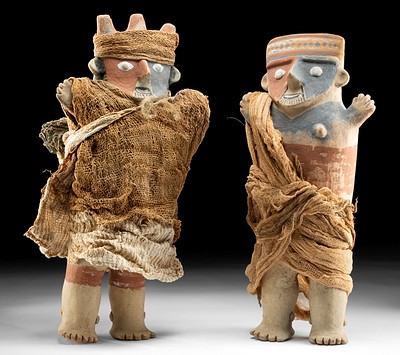Large / Expressive Roman Marble Spout - Lion Head Form
Lot 42
About Seller
Artemis Gallery
686 S Taylor Ave, Ste 106
Louisville, CO 80027
United States
Selling antiquities, ancient and ethnographic art online since 1993, Artemis Gallery specializes in Classical Antiquities (Egyptian, Greek, Roman, Near Eastern), Asian, Pre-Columbian, African / Tribal / Oceanographic art. Our extensive inventory includes pottery, stone, metal, wood, glass and textil...Read more
Estimate:
$7,000 - $10,500
Absentee vs Live bid
Two ways to bid:
- Leave a max absentee bid and the platform will bid on your behalf up to your maximum bid during the live auction.
- Bid live during the auction and your bids will be submitted real-time to the auctioneer.
Bid Increments
| Price | Bid Increment |
|---|---|
| $0 | $25 |
| $300 | $50 |
| $1,000 | $100 |
| $2,000 | $250 |
| $5,000 | $500 |
| $10,000 | $1,000 |
| $20,000 | $2,500 |
| $50,000 | $5,000 |
| $100,000 | $10,000 |
| $200,000 | $20,000 |
About Auction
By Artemis Gallery
May 19, 2022
Set Reminder
2022-05-19 10:00:00
2022-05-19 10:00:00
America/New_York
Bidsquare
Bidsquare : Fine Antiquities | Ethnographica | Fine Art
https://www.bidsquare.com/auctions/artemis-gallery/fine-antiquities-ethnographica-fine-art-9350
Featuring a very special collection of Fine Art from the Hollywood Hills, including Picasso & Rookwood ceramics! Also included are many fine examples of classical antiquities, ancient, and ethnographic art from cultures encompassing the globe. Artemis Gallery info@artemisgallery.com
Featuring a very special collection of Fine Art from the Hollywood Hills, including Picasso & Rookwood ceramics! Also included are many fine examples of classical antiquities, ancient, and ethnographic art from cultures encompassing the globe. Artemis Gallery info@artemisgallery.com
- Lot Description
Roman, Imperial Period, ca. 3rd century CE. A finely carved marble lion-headed spout, likely from an ancient fountain, with wonderful deep drilling characteristic of the 3rd century that results in dramatic light and shadow effects - similar to the carving technique for sarcophagi of this period. One cannot help but appreciate the fierce countenance of this wild feline, with its deep-set leering eyes, furrowed brow, pronounced muzzle, and open mouth that exposes a lagging tongue - this expressive visage crowned by an elaborately delineated wavy mane. The sculptor who made this piece may have been inspired by lions at the Roman Forum or in an amphitheater local to his area. A wonderful piece replete with superb technique and expression. Just imagine the ancients walking through a villa garden and passing a lovely fountain as water trickled and flowed from the mouth of this noble beast. Size: 11.8" W x 10.3" H (30 cm x 26.2 cm); 14.8" H (37.6 cm) on included custom stand.
In the classical world, lions symbolized power, wealth, and might. They were famously featured in many ancient myths, perhaps the most famous being that of Hercules (Greek Herakles) slaying the Nemean lion for his first labor. The lion's fur was believed to be impenetrable to attacks since according to legend it was made of gold and its claws were far sharper than swords with the power to slice through armor. In the end, Hercules defeated the lion by strangling it and wore its skin.
Lions were also favorite iconography for buildings, coins, and statues. Examples include the Lion Gate to the Citadel of Mycenae, the Terrace of the Lions on the island of Delos, and the lion hunt mosaic from Pella featuring Alexander engaged in a lion hunt. Of course, lions were also used in the Roman arenas where they would fight other animals, such as tigers and bears.
Provenance: private Philadelphia, Pennsylvania, USA collection; ex-Artemis Gallery, Louisville, Colorado, USA, September 26th, 2019, lot 77A; ex-East Coast collection, New York Gallery, New York City, New York, USA, acquired before 2010; ex-Vincent Gorda collection (1897 to 1979) thence by descent
All items legal to buy/sell under U.S. Statute covering cultural patrimony Code 2600, CHAPTER 14, and are guaranteed to be as described or your money back.
A Certificate of Authenticity will accompany all winning bids.
PLEASE NOTE: Due to recent increases of shipments being seized by Australian & German customs (even for items with pre-UNESCO provenance), we will no longer ship most antiquities and ancient Chinese art to Australia & Germany. For categories of items that are acceptable to ship to Australia or Germany, please contact us directly or work with your local customs brokerage firm.
Display stands not described as included/custom in the item description are for photography purposes only and will not be included with the item upon shipping.
#171650Fragment of a larger piece. Expected surface wear commensurate with age. Normal chips and minor losses to high-pointed areas and peripheries. Deposits with areas of encrustation grace the surface. Otherwise, excellent with collection labels on verso.Condition
- Shipping Info
-
All shipping is handled in-house for your convenience. Your invoice from Artemis Gallery will include shipping calculation instructions. If in doubt, please inquire BEFORE bidding for estimated shipping costs for individual items.
-
- Buyer's Premium



 EUR
EUR CAD
CAD AUD
AUD GBP
GBP MXN
MXN HKD
HKD CNY
CNY MYR
MYR SEK
SEK SGD
SGD CHF
CHF THB
THB













